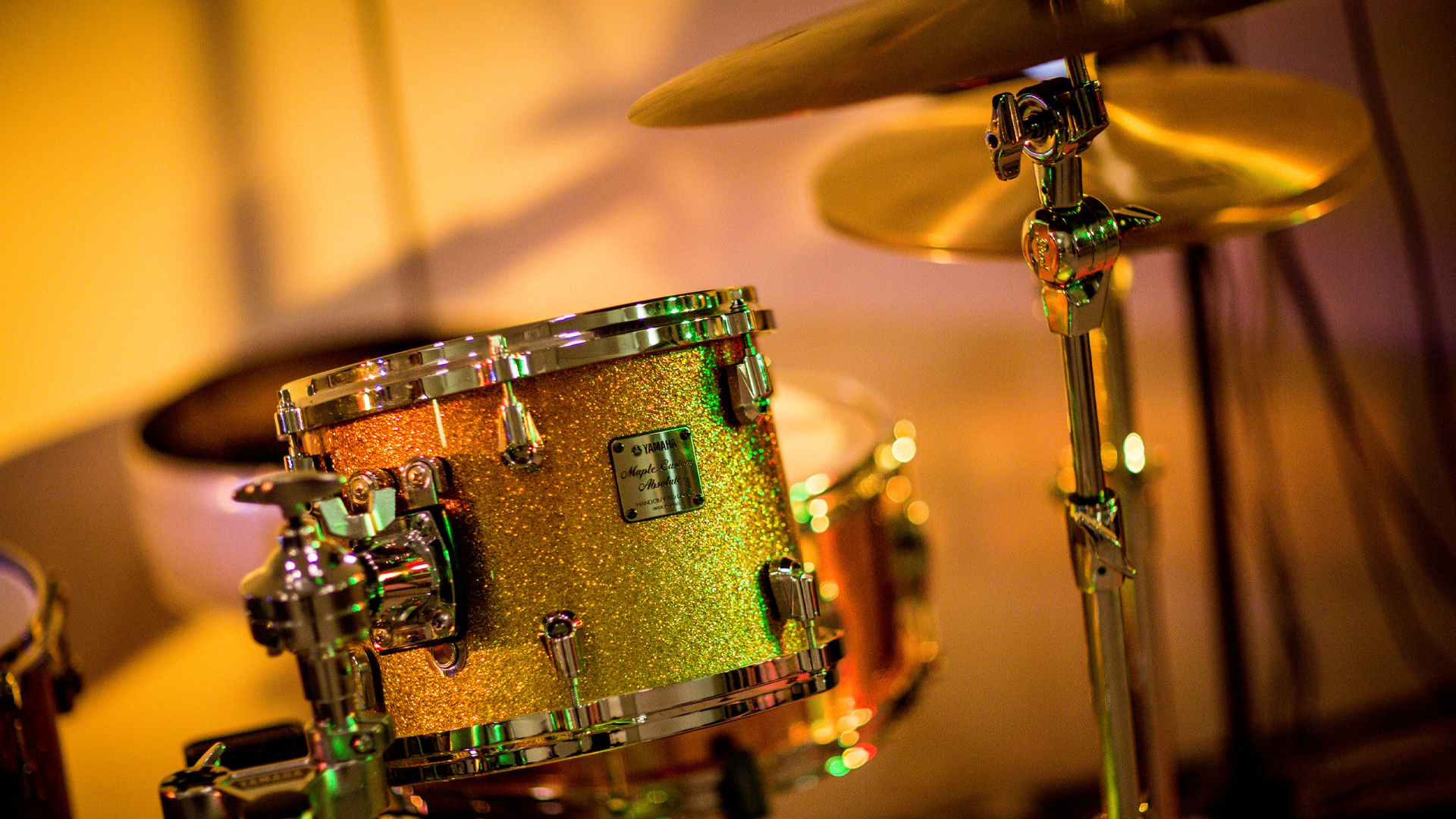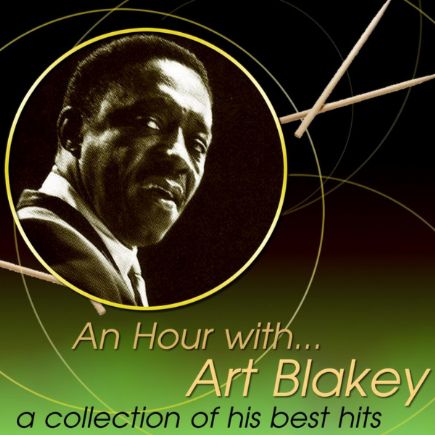Art Blakey et l’art de faire parler les tambours
Batteur et chef d’orchestre américain, Art Blakey compte parmi les figures majeures du jazz moderne. Aux côtés de Kenny Clarke et Max Roach, il est l’un des pionniers de la batterie bebop, contribuant à révolutionner le rôle de l’instrument dans le langage du jazz. Avec The Jazz Messengers, formation qu’il a dirigée pendant plus de trois décennies, Blakey a façonné un style percussif à la fois puissant, ancré dans le blues et traversé d’un esprit funky, qui continue d’influencer les générations actuelles.
L’une de ses grandes contributions réside dans l’émancipation de la batterie, qu’il propulse hors de sa fonction purement rythmique pour en faire un instrument soliste à part entière, capable de diriger l’ensemble. Sans formation académique, Blakey débute au piano, qu’il joue d’oreille. Il gagne ses premiers cachets comme pianiste de bar, vivant de pourboires, jusqu’au jour où Erroll Garner lui suggère de changer d’instrument. Par nécessité plus que par choix, il se tourne vers la batterie — une décision qui allait marquer l’histoire du jazz.
En 1939, il intègre l’orchestre de Fletcher Henderson, puis rejoint le big band de la pianiste Mary Lou Williams. Dans les années 1940, alors que le bebop est en pleine effervescence, Blakey entre dans ce nouveau courant. En 1944, il est engagé par le chanteur Billy Eckstine, dont l’orchestre devient un creuset du bebop, fréquenté par Charlie Parker, Dizzy Gillespie et Thelonious Monk. Ce dernier l’invite en 1947 à participer à ses premiers enregistrements pour le label Blue Note, marquant le début d’une collaboration féconde, en trio, quintette ou sextette.
À la mort de sa femme, Blakey entreprend un voyage de deux ans en Afrique, d’où il revient transformé, converti à l’islam sous le nom d’Abdullah Ibn Buhaina. Dans les années 1950, il rejoint l’orchestre du clarinettiste Buddy DeFranco, où il reste jusqu’en 1953. Mais c’est en 1954, aux côtés du pianiste Horace Silver, qu’il entre dans une nouvelle ère: leur enregistrement en public au Birdland — A Night at Birdland — compte parmi les premiers albums live marquants de l’histoire du jazz.
Cette période marque le début de la phase la plus féconde de sa carrière. Avec The Jazz Messengers, Art Blakey fonde une véritable école de jazz, un laboratoire où se forment nombre de futurs grands noms : Lee Morgan, Wayne Shorter, Freddie Hubbard, Benny Golson, Wynton Marsalis, pour n’en citer que quelques-uns. Entre le milieu des années 1950 et la fin des années 1980, il dirige avec constance l’une des formations les plus emblématiques du jazz moderne, incarnant à la fois une exigence artistique, un esprit de transmission, et une énergie scénique inépuisable.
Art Blakey y el arte de hacer hablar a la batería
Baterista y director de orquesta estadounidense, Art Blakey es una de las figuras fundamentales del jazz moderno. Junto a Kenny Clarke y Max Roach, fue uno de los pioneros de la batería bebop, contribuyendo a revolucionar el papel del instrumento en el lenguaje del jazz. Con The Jazz Messengers —formación que dirigió durante más de treinta años— Blakey forjó un estilo percusivo poderoso, profundamente arraigado en el blues y con un marcado espíritu funky, que sigue influyendo en nuevas generaciones de músicos.
Una de sus grandes aportaciones fue emancipar la batería de su función meramente rítmica, para convertirla en un instrumento solista pleno, capaz incluso de liderar el conjunto. Sin formación académica, Blakey comenzó tocando el piano de oído. Consiguió sus primeros ingresos como pianista de bar, sobreviviendo con propinas, hasta que Erroll Garner le sugirió que cambiara de instrumento. Por necesidad más que por elección, se orientó hacia la batería —una decisión que transformaría el curso del jazz.
En 1939 se incorporó a la orquesta de Fletcher Henderson y luego al big band de la pianista Mary Lou Williams. En los años cuarenta, en plena efervescencia del bebop, Blakey se sumergió en este nuevo lenguaje musical. En 1944 fue contratado por el cantante Billy Eckstine, cuya orquesta fue semillero del bebop y punto de encuentro de Charlie Parker, Dizzy Gillespie y Thelonious Monk. Este último lo convocó en 1947 para grabar sus primeros discos con el sello Blue Note, iniciando así una colaboración fecunda en tríos, quintetos y sextetos.
Tras la muerte de su esposa, Blakey emprendió un viaje de dos años a África. A su regreso, convertido al islam, adoptó el nombre de Abdullah Ibn Buhaina. En los años cincuenta se unió a la orquesta del clarinetista Buddy DeFranco, donde permaneció hasta 1953. Pero fue en 1954, junto al pianista Horace Silver, cuando entró en una nueva etapa: su grabación en directo en el Birdland —A Night at Birdland— está considerada como uno de los primeros álbumes en vivo esenciales del jazz.
Este periodo marcó el inicio de la etapa más fructífera de su carrera. Con The Jazz Messengers, Art Blakey fundó una auténtica escuela de jazz, un laboratorio donde se formaron grandes figuras como Lee Morgan, Wayne Shorter, Freddie Hubbard, Benny Golson o Wynton Marsalis, entre muchos otros. Desde mediados de los años cincuenta hasta finales de los ochenta, dirigió con constancia una de las formaciones más emblemáticas del jazz moderno, encarnando una exigencia artística constante, un espíritu de transmisión y una energía escénica inagotable.
Art Blakey e l’arte di far parlare la batteria
Batterista e direttore d’orchestra statunitense, Art Blakey è una delle figure centrali del jazz moderno. Insieme a Kenny Clarke e Max Roach, fu tra i pionieri della batteria bebop, contribuendo a ridefinire radicalmente il ruolo dello strumento nel linguaggio jazzistico. Con The Jazz Messengers — formazione da lui guidata per oltre trent’anni — Blakey creò uno stile percussivo potente, profondamente radicato nel blues e attraversato da un’energia funky, tuttora influente sulle nuove generazioni di musicisti.
Uno dei suoi maggiori contributi fu l’emancipazione della batteria dal semplice accompagnamento ritmico: Blakey la trasformò in uno strumento solista a pieno titolo, capace anche di guidare l’ensemble. Privo di formazione accademica, iniziò come pianista autodidatta. Suonava nei bar e viveva di mance, finché Erroll Garner non gli suggerì di cambiare strumento. Per necessità più che per vocazione, passò alla batteria — una svolta che avrebbe segnato la storia del jazz.
Nel 1939 entrò nell’orchestra di Fletcher Henderson, poi nel big band della pianista Mary Lou Williams. Negli anni Quaranta, mentre il bebop prendeva slancio, Blakey si immerse in questo nuovo stile. Nel 1944 fu chiamato dal cantante Billy Eckstine, la cui orchestra divenne un punto nevralgico del bebop, frequentata da Charlie Parker, Dizzy Gillespie e Thelonious Monk. Fu proprio Monk a invitarlo, nel 1947, a registrare per la Blue Note, dando inizio a una feconda collaborazione in trio, quintetto e sestetto.
Dopo la morte della moglie, Blakey compì un viaggio di due anni in Africa. Al suo ritorno, convertito all’Islam, assunse il nome di Abdullah Ibn Buhaina. Negli anni Cinquanta entrò nell’orchestra del clarinettista Buddy DeFranco, dove rimase fino al 1953. Ma fu nel 1954, con il pianista Horace Silver, che aprì un nuovo capitolo: la registrazione dal vivo al Birdland — A Night at Birdland — è oggi considerata uno dei primi album live fondamentali della storia del jazz.
Da quel momento iniziò il periodo più fertile della sua carriera. Con The Jazz Messengers, Art Blakey fondò una vera e propria scuola di jazz, un laboratorio di talenti da cui emersero nomi come Lee Morgan, Wayne Shorter, Freddie Hubbard, Benny Golson, Wynton Marsalis e molti altri. Tra la metà degli anni Cinquanta e la fine degli anni Ottanta, diresse una delle formazioni più emblematiche del jazz moderno, incarnando al tempo stesso rigore artistico, spirito pedagogico ed energia scenica inesauribile.
Art Blakey and the art of making the drums speak
American drummer and bandleader Art Blakey stands as one of the great architects of modern jazz. Alongside Kenny Clarke and Max Roach, he was a pioneer of bebop drumming, helping to redefine the drummer’s role within the jazz idiom. With The Jazz Messengers — the group he led for over thirty years — Blakey developed a bold, blues-infused, and funky percussive style that continues to inspire new generations of musicians.
One of his most important contributions was elevating the drum kit from its traditional role as mere rhythmic support to that of a full-fledged solo and leading instrument. Without formal training, Blakey began his musical life as a self-taught pianist. He earned his living playing in bars for tips, until Erroll Garner encouraged him to switch instruments. Driven more by necessity than by choice, he turned to the drums — a decision that would leave an indelible mark on jazz history.
In 1939, he joined Fletcher Henderson’s orchestra and later played with the big band of pianist Mary Lou Williams. By the 1940s, as bebop emerged, Blakey became immersed in the new movement. In 1944, he was hired by singer Billy Eckstine, whose orchestra served as a breeding ground for bebop and brought Blakey into contact with Charlie Parker, Dizzy Gillespie, and Thelonious Monk. In 1947, Monk invited him to record for Blue Note, beginning a fruitful series of sessions in trio, quintet, and sextet formats.
After the death of his wife, Blakey spent two years traveling in Africa. Upon returning, he converted to Islam and adopted the name Abdullah Ibn Buhaina. In the 1950s, he joined clarinetist Buddy DeFranco’s orchestra, where he played until 1953. But 1954 marked a turning point: alongside pianist Horace Silver, he recorded A Night at Birdland, one of the first and most influential live jazz albums.
This marked the beginning of the most productive chapter in his career. With The Jazz Messengers, Art Blakey created a true jazz academy — a laboratory where some of the genre’s greatest talents emerged, including Lee Morgan, Wayne Shorter, Freddie Hubbard, Benny Golson, and Wynton Marsalis. From the mid-1950s to the late 1980s, he led one of the most iconic ensembles in modern jazz, embodying artistic rigor, a spirit of mentorship, and tireless onstage energy.


Autres articles – Otros artículos – Altri articoli
Kenny CLARKE (09.01.1914–26.01.1985)
Billy ECKSTINE (08.07.1914–08.03.1993)
Dizzy GILLESPIE (21.10.1917–06.01.1993)
Benny GOLSON (25.01.1929–21.09.2024)
Erroll GARNER (15.06.1921–02.01.1977)
Fletcher HENDERSON (18.12.1897–29.12.1952)
Freddie HUBBARD (07.04.1938–29.12.2008)
Thelonious MONK (10.10.1917–17.02.1982)
Lee MORGAN (10.07.1938–19.02.1972)
Charlie PARKER (29.08.1920–12.03.1955)
Max ROACH (10.01.1924–16.08.2007)
Wayne SHORTER (25.08.1933–02.03.2023)
Horace SILVER (02.09.1928–18.06.2014)
Styles de jazz – Estilos de jazz – Stili di jazz – Jazz Styles
Confirmation–21.02.1954–Art BLAKEY & Clifford BROWN
Lady Bird–23.11.1955–THE JAZZ MESSENGERS
Liza–17.03.1956–Thelonious MONK
All The Things You Are–06.04.1957–Johnny GRIFFIN
Misterioso–14.04.1957–Sonny ROLLINS
Autumn Leaves–09.03.1958–Cannonball ADDERLEY & Miles DAVIS
Love For Sale–09.03.1958–Cannonball ADDERLEY & Miles DAVIS
Star Eyes–16.03.1958–Tina BROOKS
Groovin’ High–28.10.1958–Cannonball ADDERLEY & Milt JACKSON
Come Rain Or Come Shine–30.10.1958–Art BLAKEY & THE JAZZ MESSENGERS
I Remember Clifford–22.11-17.12.1958–THE JAZZ MESSENGERS
A Night In Tunisia –14.08.1960–Art BLAKEY & THE JAZZ MESSENGERS
I Didn’t Know What Time It Was–16.06.1963–Art BLAKEY & THE JAZZ MESSENGERS
How Deep Is The Ocean–19.06.1981–Art BLAKEY & THE JAZZ MESSENGERS

